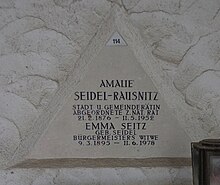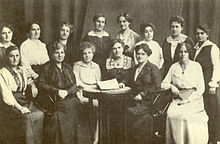Amalie Seidel

Amalie Seidel (born February 21, 1876 in Vienna , † May 11, 1952 ) was an Austrian social democratic politician and women's rights activist.
Life
In 1876 the daughter of a locksmith was born as Amalie Ryba. 13 of her siblings died while she herself had to work as a maid at the age of 12.
In 1895 she married the engineer Richard Seidel, with whom she had 2 daughters whom she raised alone after the breakup of the marriage. In 1938 she married again and was last called Amalie Seidel-Rausnitz.
In 1892 she joined the Gumpendorfer Arbeiterbildungsverein. After she appeared publicly, she was sentenced to 3 weeks in prison. Afterwards she worked as a textile worker and organized the first women’s strike in Austria, calling for a reduction in daily working hours from 13 to 10 hours and for May 1 to be off work. It was called Strike of the 700 . In addition, she was a leader in the consumer movement. She was involved in the women's movement and became the secretary of the reading and debating club Libertas . After several years of marriage, Amalie Seidel became chairwoman of the women's district committee in 1900 and of the women's empire committee in 1902. The years before the First World War were the years of her strongest commitment to women's emancipation.
After the proclamation of the republic, Amalie Seidel was a councilor from 1919–1923 and a member of the National Council from 1919–1934 . The main focus of her political activity was on child welfare and health care. She fought against the system of foster parents, in which the children of private foster parents were often only taken in because of the money involved and the acquisition of additional workers. In 1920 she founded the Vienna Youth Welfare Organization and initiated the children's outdoor pools in Vienna. At that time she worked particularly with Julius Tandler .
After the February fighting in 1934 , she was imprisoned for a month and then withdrew from politics forever. However, she made her apartment available for illegal meetings of socialist women.
In 1938 she married the Jewish local politician Sigmund Rausnitz in order to protect him through this marriage. However, he committed suicide in 1942, which hit Amalie Seidel hard. In 1944, after the assassination attempt on Hitler, she was imprisoned in the Vienna Regional Court for a few days.
After the Second World War, Amalie Seidel finally lived with her daughter Emma and her husband Karl Seitz , the former head of state, party chairman of the SDAP and mayor of Vienna .
Amalie Seidel and Emma Seitz are buried in the arcade courtyard of the Simmering fire hall in Vienna.
recognition
In 2006 the Amalie-Seidel-Weg in Vienna- Meidling was named after her in honor of her.
literature
- Edith Probst (ed.): The party never disappointed me. Austrian social democrats . Publishing house for social criticism, Vienna 1989
- Felix Czeike (Ed.): Seidel Amalie. In: Historisches Lexikon Wien . Volume 5, Kremayr & Scheriau, Vienna 1997, ISBN 3-218-00547-7 , p. 194 ( digitized version ).
- Amalie Seidel in the Vienna History Wiki of the City of Vienna
Web links
- Amalie Seidel on the website of the Austrian Parliament
- Amalie Seidel. In: dasrotewien.at - Web dictionary of the Viennese social democracy. SPÖ Vienna (Ed.)
- Renner Institute ( Memento from November 8, 2009 in the Internet Archive )
- Detailed biography, University of Vienna
| personal data | |
|---|---|
| SURNAME | Seidel, Amalie |
| BRIEF DESCRIPTION | Austrian politician and women's rights activist, member of the National Council |
| DATE OF BIRTH | February 21, 1876 |
| PLACE OF BIRTH | Vienna |
| DATE OF DEATH | May 11, 1952 |
| Place of death | Vienna |


